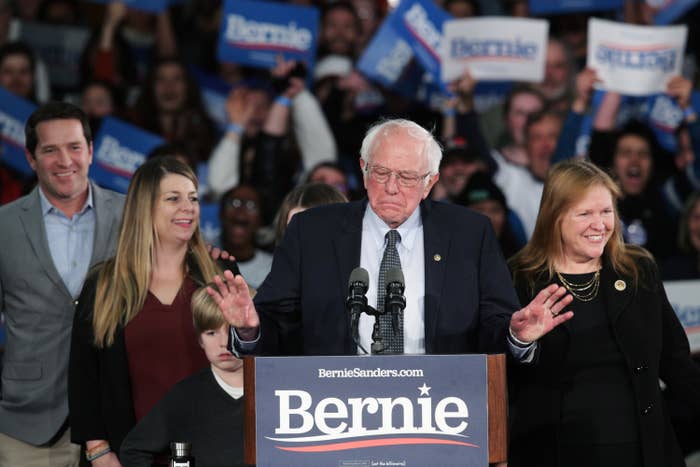
MILFORD, New Hampshire — What do you say after a year of work — work by the candidate and his staffers, by the volunteers those staffers recruit, and by all the people who show up to caucus in common cause on the big day — when it all comes down to one surreal anticlimax?
At 12:30 p.m. the day after a coding error derailed the Iowa caucuses, still facing an uncertain top finish, the Bernie Sanders campaign convened an all-staff call.
“We cannot lose sight of what matters most here: winning this damn nomination,” his campaign manager, Faiz Shakir, told his team after a sleepless night.
As results started coming in on Tuesday, there was no great celebration, just a quiet mix of exhaustion and resolve, for the sort-of-victorious Sanders campaign.
The senator and his aides believe they are winning the most important measure of the complicated Iowa caucus process: the raw votes. With results from 75% of state precincts as of Wednesday afternoon, former South Bend, Indiana, mayor Pete Buttigieg has a slight lead in the percentage of state delegate equivalents, the standard that in the past has determined the caucus winner, while Sanders currently leads in the both rounds of caucus voting, including after the so-called realignment process, when voters backing candidates who don’t reach threshold of 15% support at a caucus may choose to realign with another candidate. Sanders and Buttigieg are at the moment tied in pledged delegates, the measure that ultimately decides the nominee at the Democratic National Convention.
On Wednesday night, Sanders’s state director, Misty Rebik, emailed a memo to Iowa staff and supporters, saying campaign officials still believed they had “a viable path forward to achieve a clean sweep and retake the lead in state delegate equivalents and national pledged delegates.” The memo pointed mainly to results yet to come from Iowa’s satellite caucuses, which she said she believes Sanders won “overwhelmingly.” Satellite caucuses were held earlier in the day for Iowans out of state, but were also designed in part to allow workers and students, two chief components of the Sanders electorate, a chance to caucus earlier in the day.
As results continue to trickle in, the Sanders team seems to have grown resigned to the reality that what might have been a momentous occasion for its campaign and “political revolution” — leading the vote in the first contest of the nominating process — is now muddled by a delayed result, an opaque caucus process gone awry, and a poorly built smartphone app.
It has been a chaotic and confusing end to the yearlong race to win Iowa, as campaigns gathered their supporters for caucus night parties in hotel ballrooms in Des Moines, only to wait, and wait, and keep waiting, for election results that never came. Sanders supporters, crowding into a large hall inside the airport Holiday Inn, watched live CNN coverage on large projectors. “QUESTIONS MOUNT OVER DELAY OF IOWA CAUCUS RESULTS,” read a chyron that hardly changed all night. Eventually, they cut the sound. By midnight, there was Sanders, delivering his usual stump speech.
The next morning, tired aides were milling around the lobby of the Holiday Inn, still without results. Pete D’Alessandro, the senator’s longtime man in Iowa, was talking about the young staffers and volunteers who were, he said, bewildered by what had happened.
“They don't get their story here,” D’Alessandro said.
Around noon on Tuesday, Sanders crossed an ice-cold tarmac in Des Moines to join his staff and members of the press on his campaign plane, leaving the state for perhaps the last time after a yearlong effort here that spanned 120 campaign events and millions of dollars.
At the rear of his Boeing 737, Sanders addressed a crush of reporters and television cameras about what he described as negligence by the Iowa Democratic Party to deliver clear and timely results. Imagine how many voters are deflated by the process, he said. “If I’m a first-time voter and I came out and voted — and the results are not coming in for 16 hours? You know, that’s a little disconcerting.”
By his side, the candidate’s closest adviser, Jeff Weaver, outlined the campaign’s latest internal data, reading off their partial estimates from a sheet of paper. To his right, Sanders stood motionless in the aisle, a stolid expression on his face.
Senator, a reporter asked, are you declaring victory?
Buttigieg had already — kind of.
“No,” Sanders snapped back, “what we’re declaring is what Jeff just talked about, based on the information we receive from our precinct captains.”
By the time he arrived in New Hampshire, the next state on the primary calendar, the Iowa debacle had become a half-hearted applause line. “For some reason in Iowa, they’re having a little bit of trouble counting votes. But I am confident that here in New Hampshire, I know you’ll be able to count your votes on election night,” he told a crowd of 1,300 on Tuesday night at an athletic complex in Milford.
“And when you count those votes, I look forward to winning here in New Hampshire.”
The Iowa results so far do reflect a remarkable start to the nominating process and a personal vindication for Sanders and his brand of class-based politics. Four years after falling short in his first presidential campaign, and four months after a heart attack threatened to end his second, the 78-year-old senator appears to have won more Iowa voters than his 11 rivals.
Sanders sees his movement as squarely based in the politics of class — a mode of organizing he believes the political establishment neither understands nor is willing to embrace.
“This is unique,” Sanders told supporters on the day before the caucus. “Ain’t no other campaign doing this.”
If his 2016 bid began as a self-described “educational campaign” — a one-man crusade to spread his message about economic inequality, corporate greed, and a rigged political system — then four years later, Sanders has pursued victory with a more personalized message to the American working class: Over the last year, he has used his campaign and massive digital platform to emphasize individual stories of, in particular, people struggling with medical, credit, and student debt, and the crippling anxiety that working people face daily.
The mix of philosophy and strategy is unusual, but central to Sanders’ view of movement politics.
And he has promised voters with great confidence that his strategy will bring new voters, most of them poor or working class, into the political process.
“It is a gamble to see whether we can bring those people into the political process,” he said in an interview last year. “One way you do it is to say, ‘You see that guy? He’s YOU. You’re workin’ for $12 an hour, you can’t afford health insurance — so is he. Listen to what he has to say. It’s not Bernie Sanders talking, you know? It’s that guy. Join us.'”
Iowa was the first test of that gamble: Initial reports have suggested voter turnout is just above or on pace for the levels set in 2016, when about 170,000 participated in the contest between Sanders and Hillary Clinton. That level would be well below the almost 240,000 Iowa voters that set a record in 2008 during Barack Obama’s first presidential campaign.
Monday’s figure came as a clear disappointment to Sanders. The day before the caucus, he asked his supporters to help drive a victory with “the largest voter turnout in the history of the Iowa caucus.”
It’s ending up to be, it seems, another mixed result.
“Somewhat higher” than 2016, Sanders told reporters before heading to New Hampshire. Just “not as high, frankly,” he said, “as I would have liked to have seen.”

